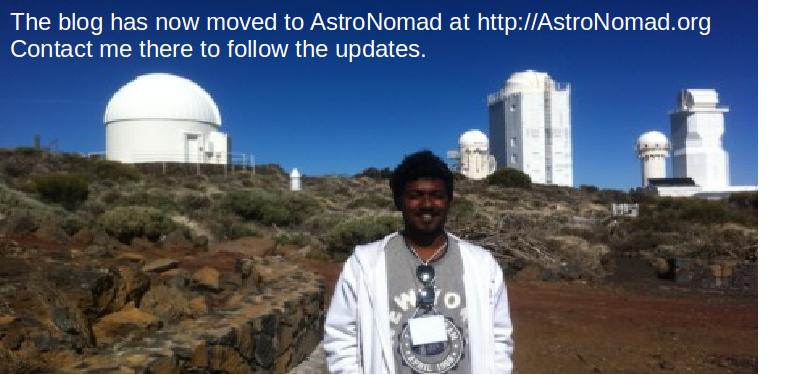
In this blog post I'll provide you guys the rest of the questions of the Astronomy and Astrophysics Olympiad as continued from the previous post at http://iya2009sl.blogspot.com/2009/07/guide-for-astronomy-astrophysics.html This will feature the second segment of the questions. As I have told you earlier, please don't hesitate to put a PM and get any explanation, answer known.
11. The brightest star of the Scorpion constellation is
a) Sirius b) Regulus c) Antares d) Polaris
12. There a two stars A and B with apparent magnitudes 1 and 3, respectively. The correct
expression about their apparent brightness is
a). Star A is 6 times brighter than the star B.
b). Star A is 6 times fainter than the star B.
c). Star A is 6.310 times brighter than the star B.
d). Star A is 2.512 times brighter than the star B.
13. The weight of a man on Earth’s surface is 60 kg. If he goes to the planet Mars, his weight at the Martian surface would be
a) 20 kg b) 10 kg c) 60 kg d) 120 kg
14. The escape velocity (V) of an object (at its surface) depends on its mass (M) and radius (R), and is given by V2 = (2GM/R). (Here, universal gravitational constant G = 6.67 x 10-11 m3 kg-1 s-2). Suppose a star with a escape velocity of 1800 km s-1 subsequently becomes a neutron star
having a radius 105 times smaller than the original star, the escape velocity of the neutron star
would be (V2 = V Squared)
a) 200,000 km s-1 b) 180,000 km s-1 c) 180,000 m s-1 d) 569210 km s-1
15. An observer who is on the 150 northern latitude observed a star in the Ursa Minor constellation at 9.00 p.m. local time. The star has 250 angular separations with bottom star of the pointer stars of the Ursa Major constellation. What would be the altitude of the observed star after a time lapse of 3 hours.
a) 37.50 b) 120 c) 250 d) 150
16. A comet orbiting around the Sun has a perihelion distance of 2.0 A.U. and an aphelion distance of 6.0 A.U. Eccentricity (e) of its elliptical orbit is
a) 0.4 b) 0.5 c) 0.7 d) 1.0.
17. Using the Kepler’s third law compute the period of an asteroid orbiting around the Sun having a semi-major axis of 4.0 AU (astronomical Units). The answer in Earth years is
a) 3 b) 4 c) 8 d) 76
18. If the orbital speed of earth as 30 km/s and distance between the Earth and the Sun as 1.5 x 10 11th power m, the mass of the Sun would be (Useful information: Universal gravitational constant G = 6.67 x 10-11 m3 kg-1 s-2).
a) 1.9 x 10 30 kg, b) 2.0 x 10 30 kg, c) 2.1 x 10 30 kg, d) Non of the above answers are correct.
19. If the focal length of the objective of a telescope is 1 m and the focal length of its eye piece is
10 mm, the magnification of the telescope is
a) 10 b) 100 c) 200 d) 1000.
20. A star gives a parallax of 0.29” when observed from the earth with a time gap of 6 months. The distance to that star in light years is
a) 3.26 b) 5.62 c) 11.24 d) 22.48.
skip to main |
skip to sidebar

A blog about International Year of Astronomy 2009 |IYA 2009 Events of Sri Lanka. Updates on Astronomy and Science Available. Now Progressing Beyond IYA...
Best Translations

- Desh
- I'm Prasanna Deshapriya, currently following my Master degree in Space Applications at USTH in Vietnam. I've graduated from University of Colombo with my Bachelor degree in Physical Science. I'm also an amateur astronomer, gazing at the skies to better discover the universe. Furthermore I voluntarily work as the NPoC of SGAC for Sri Lanka and engage myself in popularization of astronomy & space science during my free time.
Blog Archive
-
▼
2009
(127)
-
▼
July
(12)
- Abbiamo un Posto Nell'Universo Seppur Infinitesima...
- Felicitation Ceramony & Forming of Old Anandian As...
- Physics Olympiad & Astronomy and Astrophysics Olym...
- A Guide for Astronomy & Astrophysics Olympiad 2009...
- A Guide for Astronomy & Astrophysics Olympiad 2009...
- IYA 2009 Astronomy Lecture on The Doppler Effect a...
- Astronomy & Astrophysics Olympiad National Competi...
- Recalling the IYA 2009 Featured Scientist Eratosth...
- IYA 2009 Featured Scientist of the Day - Aristarch...
- IYA 2009 Featured Scientist of the Day - Heraclitus
- IYA 2009 Featured Scientist of the Day - Eratosthe...
- IYA 2009 Featured Scientist of the Day - Claudius ...
-
▼
July
(12)
Blog Archive
-
▼
2009
(127)
-
▼
July
(12)
- Abbiamo un Posto Nell'Universo Seppur Infinitesima...
- Felicitation Ceramony & Forming of Old Anandian As...
- Physics Olympiad & Astronomy and Astrophysics Olym...
- A Guide for Astronomy & Astrophysics Olympiad 2009...
- A Guide for Astronomy & Astrophysics Olympiad 2009...
- IYA 2009 Astronomy Lecture on The Doppler Effect a...
- Astronomy & Astrophysics Olympiad National Competi...
- Recalling the IYA 2009 Featured Scientist Eratosth...
- IYA 2009 Featured Scientist of the Day - Aristarch...
- IYA 2009 Featured Scientist of the Day - Heraclitus
- IYA 2009 Featured Scientist of the Day - Eratosthe...
- IYA 2009 Featured Scientist of the Day - Claudius ...
-
▼
July
(12)
How to Learn Any Language Fast
Astronomy Highlights
Learn French
Labels
- 100 HA (2)
- Akureyri (1)
- annular eclipse (1)
- Astronomy (8)
- Astronomy Outreach (7)
- aurora (1)
- borealis (1)
- Closing Ceremony (1)
- Columbia (1)
- comet (3)
- Earth (2)
- eclipse (2)
- Galileo Galilei (3)
- Galileoscope (2)
- iceland (1)
- Italy (1)
- IYA 2009 (25)
- MAS (2)
- NASA (2)
- NEWS (1)
- northern lights (1)
- Observation (4)
- Padua (1)
- reykjavik (1)
- Telescope (8)
- vedur.is (1)
Copyright © 2011 IYA 2009 - Astronomy Sri Lanka - Beyond IYA




0 Comments:
Post a Comment